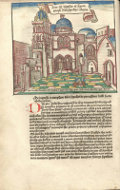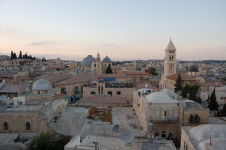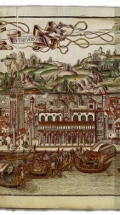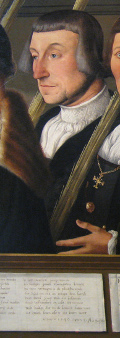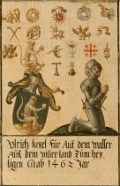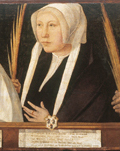The grand pilgrimage, 1333-1600
- The late medieval Jerusalem pilgrimage in practice
- Reasons for going on a Jerusalem pilgrimage
- Social composition
Jerusalem occupied a special place in the mind of Christian medieval man. The city had become the most important place in Christendom, because it was the place of the death and resurrection of Christ. Already in the first centuries A.D., Western European Christians went on pilgrimages to the holy places. A curious form of these were the crusades, which combined military conquest of the Holy Land with pilgrimage.
The loss of Acre (1291), which also meant loss of European control over Palestine, did not cause the pilgrimages to end, however. On the contrary, the pilgrimage had its heyday from the fourteenth century onwards. Together with Rome and Santiago, Jerusalem was one of the three great destinations for pilgrims in the later Middle Ages. In the sixteenth century, under the influence of the (Counter)Reformation, religious wars, and Ottoman conquests, the number of pilgrims declined quickly.1
The late medieval Jerusalem pilgrimage in practice
The Jerusalem pilgrimage was an expensive and dangerous undertaking. The journey took months, there were dangers of shipwreck, an unknown climate, and an often hostile population. Most pilgrims traveled through Venice, where ship owners had specialized in travel to the Holy Land. Once in Palestine, the supervision was transferred into the hands of the Franciscans of the Monastery of Mount Zion, the only Catholic organisation that was allowed by the Islamic rulers. They led the pilgrims to the holy places (often in no more than two weeks), after which they travelled back to Europe. Potentially, the journey could be expanded with a trip to the Monastery of St Catherine in the Sinai, or onwards to Egypt, in which case one travelled back from Alexandria.
Reasons for going on a Jerusalem pilgrimage
Care for the souls
Why would one undertake such an expensive and dangerous journey? Although we cannot exclude a thirst for adventure and curiousity about unknown worlds for some pilgrims, the main reason for most was care for their souls. The Church taught that every non-saint awaited a stay of unknown duration in purgatory after death, and this time could be shortened by acts of penance (such as pilgrimage). At a certain moment the Church supplied indulgences for this cause, i.e. official reductions of the stay in purgatory for a certain amount of time.
Of course a visit to the single most important place in Christianity benefited the sinner most. Many and large indulgences were connected to the holy places. These were an important motive for the pilgrimage, as is attested by many travel reports still in existence, which encompass often not more than a list of holy places and the indulgences connected to them.2 Care for the souls is also shown by the portraits of pilgrims, for example on the group portrait of the Haarlem confraternity of Jerusalem pilgrims. The text accompanying the portrait of Joost Cornelisz states: wilt bidden dat mi de beuairt baten moet // int ewich leven // als ic dit laten moet
(please pray that the pilgrimage will benefit me in eternal life, when I have to leave this one).
Punishment
It was also common practice that people were sent on pilgrimage as punishment for a crime. The Jerusalem pilgrimage was an extremely heavy punishment in this regard, and was therefore rare. However, there are some recorded examples from Antwerp, Bruges, Brussels, Gouda (1 each), Leiden (2) en Brielle (3).3
Social prestige
For noble pilgrims there was another reason to go: the acquisition of various knightly titles. Of these, the most important was that of the Holy Sepulchre, which was to be granted in the Church with the same name. The great social prestige such a title bestowed upon a man made it attractive for many to travel to Jerusalem, even though the accolade was originally meant to make knights commit themselves to the crusading ideal. Moreover, in rare cases the title could be granted to non-nobles.4 Besides that, there were other knightly titles to be earned during the journey, such as that of St Catherine (on the Sinai) or the Order of Cyprus. On the latter island the desire to reconquer the Holy Land endured for a long time, and it was often visited by pilgrim's galleys as a stop-over. The prestige of these titles is shown for example by the portraits of the Nuremberg Ketzel family, who are depicted proudly in harnesses with all the signs of their acquired titles.
Social composition
The nobility made up the main part of all pilgrims, because nobles could often afford the expenses of the travel more easily than others. However, there was also a considerable number of non-nobles who undertook the journey, amongst whom an unknown number of pilgrims who begged their way to Jerusalem. This group may have been substantial, but left only few traces.5
Women also partook in the journey, but their presence was not always appreciated by their male colleagues, as is attested by some travel reports. The pilgrims entered into a kind of temporary virtual monastic order during their journey, and the presence of the sinful female sex was therefore a very sensitive matter. Generally, there were tolerated, as long as they made themselves as invisible as possible.6
This is possibly also one of the reasons why there are so few portraits of female pilgrims. Only one woman is known to be depicted as a pilgrim, on the group portrait of nine members of the Utrecht Confraternity of Jerusalem pilgrims. This is an exceptional case in other respects as well, since the accompanying text indicates that she travelled together with her husband, who surprisingly is not depicted. There are some women included on double portraits, however, on which the man is depicted as a Jerusalem pilgrim. It was not uncommon for couples to travel together,7 and it may therefore be suspected that some of these women were indeed pilgrims themselves, even though they were not depicted as such.
Previous: Introduction
Next: Commemoration of the Jerusalem pilgrimage
- Morris, Colin, The Sepulchre of Christ and the Medieval West. From the Beginning to 1600 (Oxford 2005), pp. 306-307.
- Ganz-Blättler, Andacht und Abenteuer: Berichte europäischer Jerusalem- und Santiago-Pilger (1320-1520) (Tübingen 1990).
- Wim Cerutti, Haarlemse Jeruzalemvaarders (Haarlem 2010), pp. 46-48.
Vanhemelryck, Ferdinand, Kruis en wassende maan. Pelgrimstochten naar het Heilig Land (Leuven 1994), p. 24. - Schneider, Wolfgang, Peregrinatio Hierosolymitana. Studien zum spätmittelalterlichen Jerusalembrauchtum und zu den aus der Heiliglandfahrt hervorgegangenen nordwesteuropäischen Jerusalembruderschaften (Münster 1982), p. 212.
- Herwaarden, Jan van, 'Geloof en geloofsuitingen in de late middeleeuwen in de Nederlanden: Jerusalembedevaarten, lijdensdevotie en kruiswegverering,' Bijdragen en Mededelingen betreffende de geschiedenis der Nederlanden 98 (1983), pp. 400-429, p. 410.
The accounts of the pilgrimage of count Willem I of Holland, edited in Hamaker, H.G., De rekeningen der grafelijkheid van Holland onder het Henegouwsche Huis, vol. 3, Werken Historisch Genootschap, nieuwe serie, no. 26 (Utrecht 1878), recorded a considerable amount of alms given to poor pilgrims the count met on his way. - Craig, Leigh Ann, ''Stronger than men and braver than knights': women and the pilgrimages to Jerusalem and Rome in the later middle ages', Journal of Medieval History 29:3 (2003), pp. 153-175.
- Ibid., p. 161.
